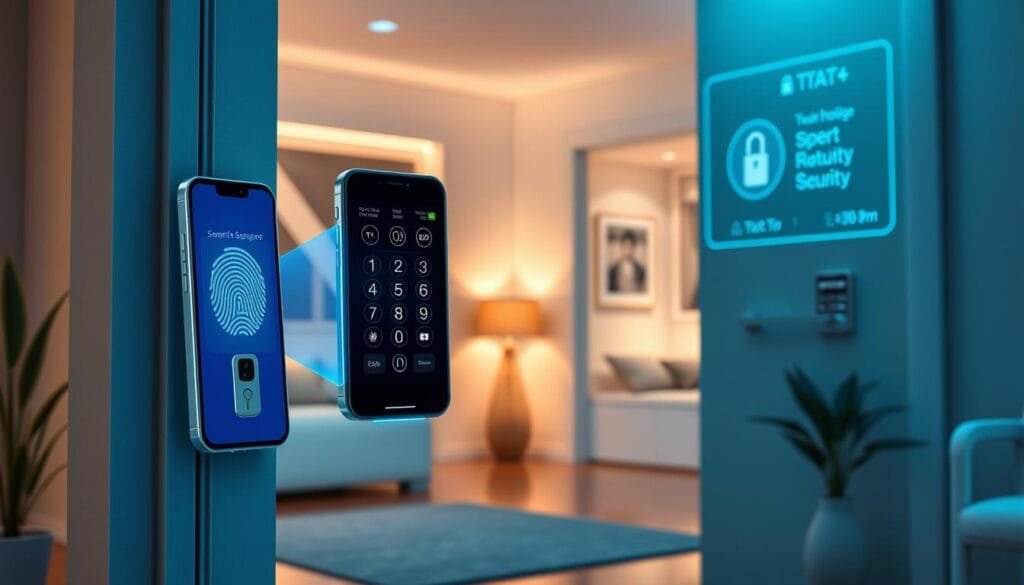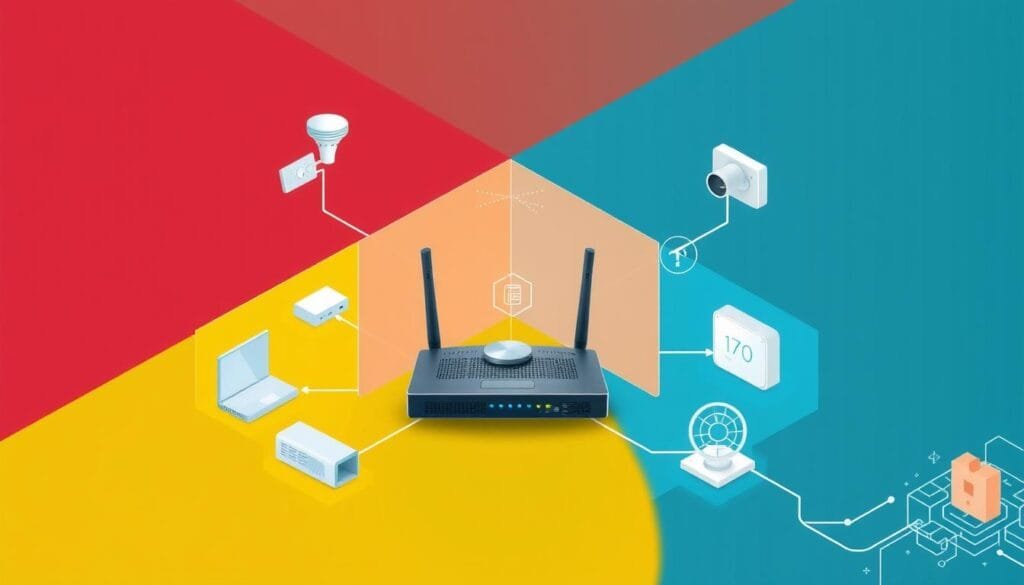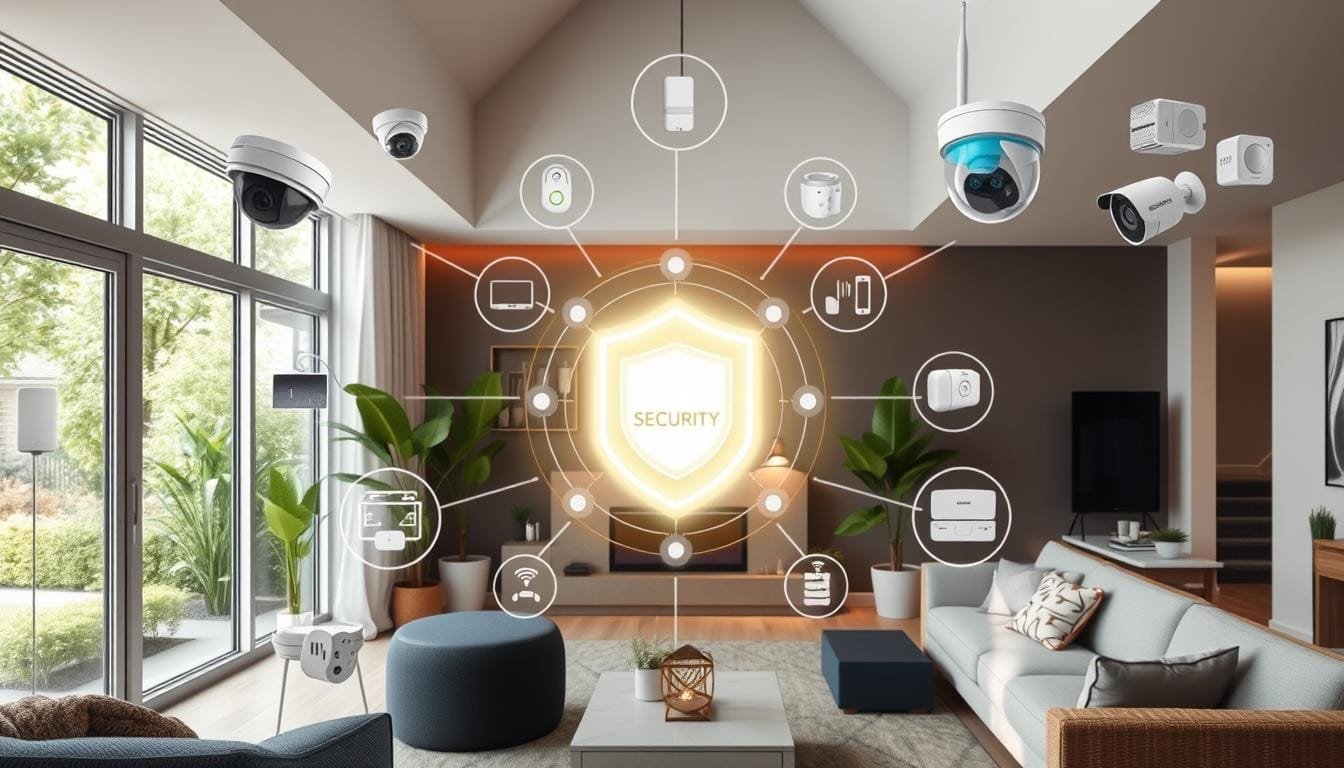Smart home devices are becoming a big part of our lives. In 2024, they will cover everything from simple household items to complex industrial equipment. These devices bring great convenience and efficiency but also attract cybercriminals. This guide will give you key tips and strategies to keep your IoT devices safe and protect your smart home from hackers.
Key Takeaways
- Understand the risks and benefits of smart home devices to make informed decisions about their use.
- Secure your Wi-Fi network by changing default router settings and using strong encryption protocols.
- Keep your IoT device firmware up-to-date to patch vulnerabilities and ensure optimal security.
- Replace outdated routers to enhance the overall security of your smart home network.
- Implement strong and unique passwords, as well as a password manager, to safeguard your IoT devices.
Understand the Risks and Benefits of Smart Home Devices
Smart home devices are becoming more popular, bringing both good and bad points. They make our lives easier by letting us control our homes from afar. They also boost security with smart cameras and locks. Plus, they help businesses and improve things like healthcare and farming.
But, using these devices can also be risky. Smart home device risks include hacking and security issues. These devices often don’t have strong security. If not updated or set up right, they can be easy targets for hackers.
Assessing Your Comfort Level with IoT Devices
Before jumping into smart home tech, think about how you feel about IoT device security vs convenience. Are you okay with devices like cameras watching your home and sending data online? Smart home privacy concerns are big, as these devices can gather a lot of personal info.
| Benefits of Smart Home Devices | Risks of Smart Home Devices |
|---|---|
|
|
Balancing Convenience with Security and Privacy
When dealing with smart home devices, find a balance between their perks and the risks. Keep up with the latest security rules, like those from the European Telecommunications Standards Institute (ETSI). By knowing the smart home device risks and how to reduce them, you can enjoy smart tech safely. This way, you protect your info and home while still getting the benefits.
Secure Your Wi-Fi Network
Protecting your smart home starts with securing your Wi-Fi network. This is the key way your IoT devices talk to each other and work. A key step is to change the default router SSID and password, which hackers can easily guess. If you don’t, your smart home could be open to unauthorized access.
Changing Default Router Settings
Many IoT devices come with easy-to-guess login details. To make your home Wi-Fi network safer, change these default settings. Create a strong, unique password for your router. This step greatly lowers the chance of cybercriminals getting into your smart home.
Using Strong Encryption Protocols
Using the latest Wi-Fi encryption protocol, like WPA3 encryption, is key to securing your home Wi-Fi network. Older protocols like WEP and WPA2 can be easily hacked. By changing router default settings and using the latest encryption, you boost your smart home network’s security.
| Wi-Fi Encryption Protocol | Security Level | Recommendation |
|---|---|---|
| WEP (Wired Equivalent Privacy) | Low | Avoid |
| WPA (Wi-Fi Protected Access) | Moderate | Upgrade to WPA3 |
| WPA2 (Wi-Fi Protected Access II) | High | Upgrade to WPA3 |
| WPA3 (Wi-Fi Protected Access III) | Highest | Recommended |
By following these steps to secure your home Wi-Fi network, you boost your smart home’s security. This protects your devices and personal info from hackers.
Keep Your Firmware Up-to-Date
In the world of smart home tech, keeping your IoT devices’ firmware updated is key. Firmware runs the software of your router, security cameras, and other gadgets. Companies often release updates to fix bugs and boost performance.
Importance of Regular Software Updates
Not updating your IoT device firmware can make you a target for cyber attacks. Old firmware has security holes that hackers can use to get into your smart home network. IoT device attacks have jumped by over 300% in a year, and about 60% of these devices have firmware flaws. Updating your firmware is crucial to fight off these threats and keep your devices working well.
Configuring Automatic Updates for IoT Devices
- Use Firmware Over-the-Air (FOTA) to let makers update your device’s firmware without you needing to do anything.
- Set your IoT devices to automatically install software updates when they’re ready, so you always have the latest security.
- FOTA can make your devices safer and run better without hassle or cost. But, it can also cause problems like changing the firmware or stopping updates to fix bugs.
By updating your IoT device firmware regularly, you protect your smart home from cyber threats. This way, you can enjoy the perks of connected living safely.
Replace Outdated Routers
In the world of smart home tech, keeping your devices safe is key. Upgrading old routers is a big step to protect your network from risks.
Old routers often use weak encryption like WEP, easy for hackers to break. They may also have bugs that hackers can exploit, like the VPNFilter malware or Mirai botnet, which hit many IoT devices worldwide.
Switching to a newer router with Wi-Fi 6 or Wi-Fi 6E brings better security and speed. These routers use strong encryption like WPA3, fighting off modern hacking methods.
| Router Feature | Benefits |
|---|---|
| Robust Encryption | Protects your network from unauthorized access and eavesdropping |
| Improved Bandwidth | Ensures seamless performance for data-heavy smart home tasks |
| Advanced Security Protocols | Helps prevent cybercriminals from exploiting vulnerabilities |
Upgrading your router boosts your smart home’s security and network performance. It lets your devices work their best. This smart move keeps your home and family safe from digital threats.
Manage Your Account Passwords
With more smart home devices around, keeping passwords safe is key. Each IoT device needs its own account and password. It’s important to use unique passwords for IoT devices to stop hackers if one password is found out.
Using Unique and Strong Passwords
Don’t make the mistake of using the same password for all accounts. This makes all your devices at risk if one password is leaked. Instead, make strong, unique passwords for each device. Use a mix of letters, numbers, and special characters to make your passwords more secure.
Implementing a Password Manager
Keeping track of all your smart home passwords can be hard. But, a password manager for smart home can help. These tools create and store complex passwords you don’t need to remember. They also offer features like multi-factor authentication and secure password sharing. This helps you avoid password reuse and keeps your devices safe.
Securing your account passwords is key to protecting your smart home from hackers. Remember, strong password habits are vital for a safe and secure connected home.
Enable Multi-Factor Authentication
Protecting your smart home devices and IoT accounts is crucial. Enabling multi-factor authentication (MFA) is a key step. MFA requires a second verification, like a code from an app, before access is granted. This stops unauthorized logins, even if your password is leaked.
Only 57% of businesses use MFA to protect their devices. This leaves a big gap in cybersecurity. By using MFA, you make it much harder for hackers to get into your smart home and IoT accounts.
To enable MFA for your smart home accounts, follow a few easy steps. First, log out and log back in after turning on MFA. This makes sure the extra security works. If you use single sign-on (SSO), an external identity provider (IdP) might manage your MFA settings.
| MFA Requirements | MFA Implementation |
|---|---|
|
|
Adding MFA to your smart home security is a strong way to keep your IoT accounts safe. This feature helps prevent unauthorized access. It ensures your data and devices are secure, giving you a safer smart home experience.

Multi-Factor Authentication (MFA) is crucial for protecting data and warding off cyberattacks, emphasizing the need for stronger security measures in industries utilizing IoT devices.
Secure IoT Devices
Smart home devices bring us convenience but also require security focus. Many IoT devices ship with easy-to-guess default usernames and passwords. This makes your home network at risk for attacks. To keep your IoT devices safe, change these default passwords to unique, strong ones for each device.
Changing Default Credentials
Not changing default IoT device passwords is a big mistake. Hackers look for these easy-to-guess login details to get into your smart home network. By using unique, complex passwords, you boost your IoT devices’ security. This protects your personal info and data too.
Updating IoT Device Software Regularly
It’s key to keep your IoT device software current for security. Manufacturers often update their products to fix vulnerabilities and boost security. Always check for and apply these updates to keep your devices safe from new threats. Set your IoT devices to update automatically if you can, to always use the latest secure software.
By changing default passwords and updating your IoT devices, you make your smart home much safer. Stay alert and focus on IoT security to keep up with the digital world’s changes.
| Recommendation | Description |
|---|---|
| Change default credentials | Replace default usernames and passwords on IoT devices with unique, strong credentials to prevent unauthorized access. |
| Update IoT device software | Regularly check for and apply software updates to ensure your IoT devices have the latest security patches and protections. |
Split Up Your Network
Keeping your smart home devices safe is key in today’s world, where hackers are always looking for ways in. A good way to do this is by making a separate network for your IoT devices. This method, called network segmentation, makes your smart home more secure by isolating IoT devices and protecting critical data.
Create a Guest Network for IoT Devices
Think about making a guest network just for your IoT devices like smart speakers, security cameras, and appliances. This network segmentation for smart home stops hackers from moving around your network if one device gets hacked. It keeps your IoT devices safe and limits the harm if there’s a threat.
Separate Critical Data from IoT Devices
Make sure your important data, like bank info, personal documents, and work files, is on a separate network. This keeps your critical data safe if there’s a breach. Use a different network or storage for your important stuff to add more security.
Many routers today have features like VLANs or dual-band options, making it easy to have separate networks for IoT and other devices. These steps can greatly improve your smart home’s security and lower the chance of a cyber attack.

“The FBI recommends segregating IoT devices into distinct networks to enhance security.”
Remember, keeping your smart home devices safe is an ongoing task. Always be alert, update your firmware, and look for new ways to protect your network and data.
Monitor Your Network
Keeping your smart home network safe is key to protecting your devices from threats. By watching your network for strange activity, you can catch and stop IoT attacks fast. This keeps your smart home safe and convenient.
Leverage Network Monitoring Tools
Tools for monitoring your network are super helpful. They show you all devices on your network and watch their actions. If something looks off, they alert you, helping you stay ahead of cyber threats.
Invest in Comprehensive Security Solutions
For better network security, think about getting a full security package for smart homes. These solutions have threat detection, prevention, and real-time watching. They protect your devices from many cyber dangers, keeping your data safe.
“Effective IoT monitoring provides insights into device functionality, helps with troubleshooting, and ensures that IoT devices operate efficiently and at peak performance.”
| Network Security Tools for IoT | Key Features |
|---|---|
| MetricFire | – Real-time monitoring and alerting- Customizable dashboards- Long-term data storage- Expert technical support |
| AWS IoT Device Management | – Device registration and provisioning- Remote device management- Over-the-air updates- Secure data communications |
| Senseye PdM | – Predictive maintenance for IoT devices- Anomaly detection and root cause analysis- Automated issue resolution- Actionable insights for optimization |
With a good monitoring and security plan for your smart home network, you get to know how your devices are doing. This keeps your home safe and connected, away from cyber threats.
Conclusion
Reflecting on this guide, I see how vital it is to secure our smart home devices. This keeps hackers out and protects our privacy and data. By securing our Wi-Fi, updating firmware, using strong passwords, and segmenting our network, we can lower the risks.
The Internet of Things (IoT) is growing fast, set to add $5-12 trillion to the economy by 2030. This growth means more devices connected, making us more vulnerable to cyber threats. But, with a strong IoT security plan and staying alert, we can keep our homes safe.
I plan to keep adding smart home tech to my life, but security will always come first. By teaching others about security, we can make a safer IoT space. This lets us enjoy smart tech without risking our privacy or safety. Let’s make our smart homes safe and strong against hackers.
FAQ
What are the benefits and risks of smart home devices?
Smart home devices make life easier and automate tasks. But, they also bring security and privacy risks. It’s vital to think about how you feel about connecting devices to the internet. You must weigh the perks against the possible risks.
How can I secure my home Wi-Fi network for smart home devices?
To secure your Wi-Fi, change your router’s default name and password. Make sure your router uses the latest Wi-Fi encryption, like WPA3. Not doing this makes your smart home easy to hack.
Why is it important to keep my smart home device firmware up-to-date?
Firmware runs your router and IoT devices’ software. Updates fix security issues and boost performance. Keeping devices updated shields them from known threats.
When should I consider upgrading my router for better smart home security?
An old router can weaken your smart home’s security. Older routers lack modern encryption and may have unpatched flaws. A newer router with Wi-Fi 7 standards offers better security and performance for your devices.
How can I manage my smart home device passwords effectively?
Use unique, strong passwords for each device to stop hackers if one password is leaked. A password manager can help generate and keep complex passwords you don’t need to remember.
Why should I enable multi-factor authentication for my smart home devices?
Multi-factor authentication (MFA) adds an extra security layer. It asks for a second verification, like an app code, before access. This stops hackers even if they get your password.
How can I secure individual IoT devices in my smart home?
Change default usernames and passwords on IoT devices to strong, unique ones. Update your gadgets’ software regularly to apply the latest security updates.
How should I segment my smart home network to improve security?
Put your smart devices on a separate network from your computers and other systems. This stops attackers from spreading if one device is hacked. Use a guest network for IoT devices and keep sensitive data separate.
How can I monitor my smart home network for potential threats?
Watch your network for suspicious activity to catch and act on IoT threats. Use network tools to see all devices and their actions. A smart home security solution can offer threat detection and protection.


